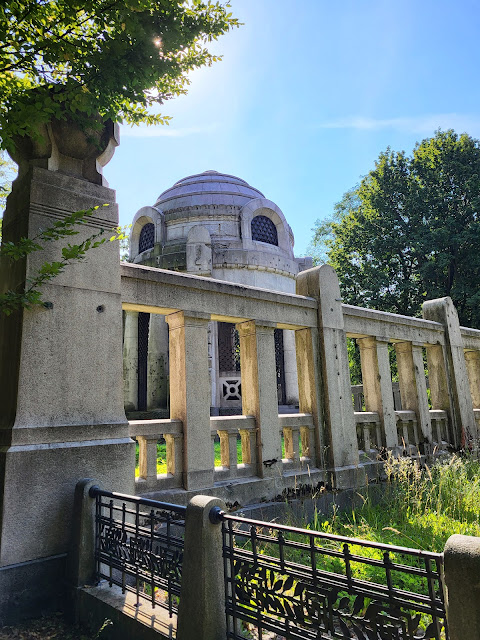Wbrew wielu przepisom religijnym, Izrael Poznański, łódzki przemysłowiec, nakazał wybudować monumentalny, secesyjny grobowiec na cmentarzu żydowskim w Łodzi. Mauzoleum zbudowane zostało z szarego granitu i marmuru w latach 1901–1903, według projektu Adolfa Zeligsona, trzy lata po śmierci Poznańskiego, który został pochowany w mauzoleum wraz z żoną Leonią.
Mauzoleum z jasnoszarego granitu umieszczono na planie koła o średnicy górnego podestu o średnicy 9,5 metra. Wysokość budowli do zwornika kopuły wynosi 15 m. Szeroki architraw, z posadowioną na nich kopułą o profilu schodkowym, oparty jest na ośmiu masywnych kolumnach i czterech filarach oddzielających pary kolumn. Widnieje na nim napis: Poznański. Kopuła wewnątrz została udekorowana od wewnątrz szklaną mozaiką, składającą się z dwóch milionów różnokolorowych kawałków. Przedstawia symbolicznie cztery rajskie rzeki. W każdym z nich umieszczono palmę na złotym tle z hebrajskimi wersetami biblijnymi po bokach, w których powtarza się imię Izrael, co jest bezpośrednim nawiązaniem do postaci zmarłego, jak i do narodu żydowskiego: m.in. „I nadszedł czas śmierci Izraela. I westchnęli synowie Izraela”.
W środku mauzoleum znajdują się dwa sarkofagi: Leonii zmarłej w 1914 i Izraela Poznańskich, wykonane one zostały przez Antoniego Urbanowskiego z czerwonego marmuru. Napisy na czołach sarkofagów są w języku polskim, a daty urodzenia i śmierci podane są według kalendarza żydowskiego.
Mauzoleum Poznańskiego do dziś uznawane jest za największy grobowiec żydowski na świecie. Grobowiec jest tak wielki, że nazywany jest ostatnim pałacem Poznańskiego.
Entgegen vielen religiösen Vorschriften ordnete Izrael Poznański, ein Industrieller aus Łódź, den Bau eines monumentalen Jugendstilgrabes auf dem jüdischen Friedhof in Łódź an. Das Mausoleum wurde in den Jahren 1901–1903 nach dem Entwurf von Adolf Zeligson aus grauem Granit und Marmor erbaut, drei Jahre nach dem Tod von Poznański, der mit seiner Frau Leonia im Mausoleum begraben wurde. Das Mausoleum aus hellgrauem Granit hatte eine kreisförmige Form mit einer oberen Plattform von 9,5 Metern Durchmesser. Die Höhe des Gebäudes bis zum Schlussstein der Kuppel beträgt 15 m. Der breite Architrav mit der darauf aufgesetzten Stufenkuppel ruht auf acht massiven Säulen und vier Säulen, die die Säulenpaare trennen. Darauf befindet sich die Inschrift: Poznański. Die Kuppel im Inneren wurde von innen mit einem Glasmosaik aus zwei Millionen verschiedenfarbigen Teilen verziert. Es stellt symbolisch die vier Flüsse des Paradieses dar. In jedem von ihnen befindet sich eine Palme auf goldenem Grund mit hebräischen Bibelversen an den Seiten, in denen der Name Israel wiederholt wird, was unter anderem einen direkten Hinweis auf die Figur des Verstorbenen sowie auf die jüdische Nation darstellt : „Und es kam die Zeit, dass Israel starb. Und die Kinder Israels seufzten. Im Inneren des Mausoleums befinden sich zwei Sarkophage: der von Leonia, die 1914 starb, und der von Izrael Poznański, gefertigt von Antoni Urbanowski aus rotem Marmor. Die Inschriften auf den Stirnseiten der Sarkophage sind in polnischer Sprache und die Geburts- und Sterbedaten sind nach dem jüdischen Kalender angegeben. Das Posener Mausoleum gilt noch immer als das größte jüdische Grab der Welt. Das Grab ist so groß, dass man es als den letzten Palast von Poznański bezeichnen kann.
In defiance of many religious regulations, Izrael Poznański, an industrialist from Łódź, ordered the construction of a monumental, Art Nouveau tomb at the Jewish cemetery in Łódź. The mausoleum was built of grey granite and marble in the years 1901-1903, according to the design of Adolf Zeligson, three years after the death of Poznański, who was buried in the mausoleum with his wife Leonia. The mausoleum made of light grey granite was placed on a circular plan with the diameter of the upper platform being 9.5 meters. The height of the building to the keystone of the dome is 15 meters. The wide architrave, with a stepped dome placed on them, is supported by eight massive columns and four pillars separating pairs of columns. It bears the inscription: Poznański. The dome inside was decorated from the inside with a glass mosaic consisting of two million multi-colored pieces. It symbolically represents the four rivers of paradise. In each of them, a palm tree was placed on a golden background with Hebrew biblical verses on the sides, in which the name Israel is repeated, which is a direct reference to the deceased and to the Jewish nation: among others, "And the time of Israel's death came. And the sons of Israel sighed". Inside the mausoleum there are two sarcophagi: Leonia, who died in 1914, and Izrael Poznański, made by Antoni Urbanowski from red marble. The inscriptions on the fronts of the sarcophagi are in Polish, and the dates of birth and death are given according to the Jewish calendar. The Poznański Mausoleum is still considered the largest Jewish tomb in the world. The tomb is so large that it is called Poznański's last palace.








Brak komentarzy:
Prześlij komentarz